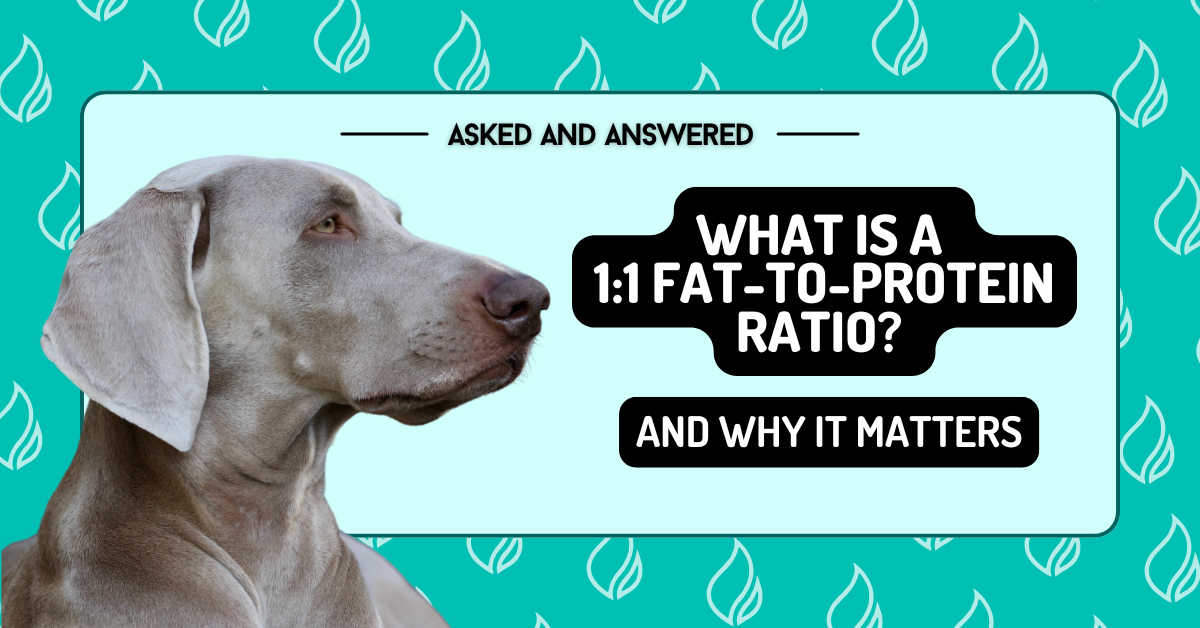What is a 1:1 Fat-To-Protein Ratio?
Understanding FAt-to-protein ratios in Dog food and why it matters
When it comes to feeding your dog for optimal health and energy, the fat-to-protein ratio in their food is one of the most critical but often misunderstood nutritional factors. While some brands use calorie-based calculations to promote high fat content, it's essential to look at weight-based formulation to truly understand the impact of your dog’s food.
So what’s the difference, and why does it matter?
What is a Fat-to-Protein Ratio?
The fat-to-protein ratio refers to the relative amounts of fat and protein in your dog’s food. This ratio can be measured either:
By weight (grams of fat vs. grams of protein), or
By calories (calories from fat vs. calories from protein)
This distinction is crucial because fat contains more than double the calories per gram than protein.
Let’s break it down:
1 gram of fat = 9 calories
1 gram of protein = 4 calories
Why Weight-Based Ratios Tell the true story
A 1:1 fat-to-protein ratio by weight means that for every gram of fat, there is one gram of protein. Because fat has more than twice the calories per gram, this ratio translates to roughly 70% of calories coming from fat—a composition that is ideal for metabolic balance in dogs.
On the other hand, a 1:1 ratio by calories ends up skewing the formula heavily toward protein by weight. That’s because you need more than twice as much protein by weight to match the calories in fat. This often results in a formula with only about 50% of calories from fat, even though the label might suggest an equal balance.
Some brands use this calorie-based approach to inflate the appearance of fat content, making the food sound more ketogenic or metabolically beneficial than it really is.
Why Does the right ratio matter?
Dogs are metabolically flexible, but their bodies prefer fat as a primary energy source, especially when not overloaded with carbohydrates. A true 1:1 fat-to-protein ratio by weight supports:
Stable blood sugar levels
Reduced glucose dependency
Better energy balance throughout the day
Improved fat metabolism
Lower risk of energy crashes or spikes
By formulating based on weight, and hitting that 1:1 ratio, your dog can effectively burn fat for energy which helps support a leaner body condition and more optimized metabolism.
Watch for misleading labels
If a label claims a “1:1 fat-to-protein ratio,” ask yourself: Is that by weight or by calories?
Here's the simple math:
1:1 ratio by weight = ~70% of calories from fat
1:1 ratio by calories = ~50% of calories from fat
So if a food only provides 50% of its calories from fat, it’s not truly balanced in a way that supports fat metabolism.
Our Philosphy
At Bones & Co., we formulate based on weight—not calories. Our recipes typically deliver around 70% of calories from fat, ensuring your dog gets the full metabolic benefits of a high-fat, moderate-protein diet. We never use misleading calculations to inflate our numbers. We believe in transparent nutrition that works with your dog’s biology, not against it.
A weight-based 1:1 ratio is your best bet for balanced energy, stable blood sugar, and optimal body composition.
Fat isn’t the enemy—it’s the fuel.

